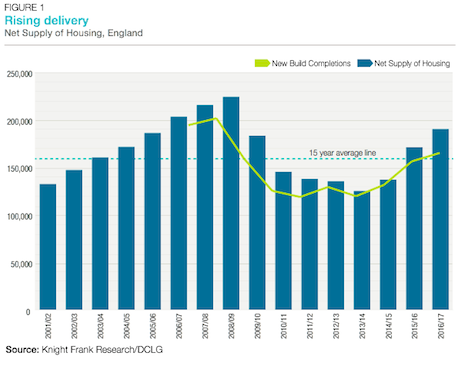With so many luxury apartments sitting vacant, a new report from Knight Frank shows that there is a continual increase in the supply of housing in England.
Knight Frank’s "Housebuilding Report 2017" found that the net housing supply in England has risen to 200,000. However, a survey questioning developers shows that the housing supply will likely increase by more than 50 percent due to builds planned within the next year.
“Overall supply of housing is climbing, but there are challenges that could weigh on delivery in the future – including labor, construction costs and planning policy,” said Grainne Gilmore, head of UK residential research at Knight Frank, London.
Building up housing
There are a multitude of luxury housing locations left unoccupied, which could be in relation to the abundant housing of the real estate market in England as a whole.
However, developers are continuing to build.

Knight Frank's graph in regards to net housing supply in England
According to Knight Frank’s survey, the biggest difficulties in developing new housing are costs of labor, availability, build costs and planning systems.
Knight Frank believes that the planning system needs to be simplified to make it easier on developers and builders. Builders are claiming that in the future it will be difficult to keep up with a supply of 200,000, similar to what has been seen this year.
The resale market in England is lower than long-term housing due to the increase in costs of transactions.
England’s increase in housing available is gratefully welcome, since the past 20 years have seen fewer and fewer properties being listed for sale. This caused a fall in liquidity and putting a strain on the market to deliver housing that is greatly needed.

Knight Frank's graph for the future
Respondents of Knight Frank’s survey that believe start volumes will rise over the next year make up 58 percent. Thirty-two percent believe it will stay the same, and 11 percent believe it will fall.
Additional insight
International home buying in the United States has had an effect on the top end of the country's residential market, but it is expected to stay the same or decrease in the next year, according to a recent study from Zillow.
Zillow's 2017 Q2 Home Price Expectations Survey, which was conducted by Pulsenomics, spoke to many experts on the U.S. housing market about the effect of buyers from outside the country on homes in the US. While international buyers are often held up as the cause of rising home prices, Zillow found that this is only really true for the most expensive homes and that more modestly priced homes have their prices affected by other factors (see more).
After a period of strong growth, development land prices in London have returned to 2014 levels, according to a separate report by Knight Frank.
Prime Central London, urban Brownfield and English Greenfield land have all seen prices decrease in the second-quarter of 2016. The impact of stamp duty is making itself clearly visible, as higher-priced areas are seeing skeptical buyers refuse to meet high demands and drive prices down (see more).
“Most surprising is probably the difference in results in several areas for large house builders and small to medium-sized builders – highlighting that they have different priorities and concerns, and policy will need to reflect this if more SMEs are going to be encouraged to get involved in sector and help boost new housing,” Knight Frank's Ms. Gilmore said.
{"ct":"m8jTE4SLYIBa0FU7h2NDlUJ3E6OXyKHmWSMYiKYlxF5+JFiEEZqKzMqlMJ2ryJuKV+af6O9\/pE\/hwmYL1ujilqm6mP2MaES3LHFutmKMdOg\/Gp\/NS5beYXuCHeLTAJUv9jBY1jnzg+7MJT\/Ujlpg3L42mZfPD6MNROmNANj0soYzlrqRBnf\/FZhMXaYceBrz1x7xA2LQZrFdvKWq7fxTNrhk2GUhLY+kFYQhPDpxCRd0Xq3C+jB9skO9vkLgrsuW9+pfKGUztkQjgWBhNSiq41qIH1nYEBg66NteKn0Lux0vrmGHs62A1\/hco2kwtFqgRk1zvwI\/EUnrq4z6acvLSUQ86AaENltdMKI0BX5sdeqyqg7WVDO3zRwRnzbc754Dk\/QymxRrM15vwkk6QvhZdjCPJ\/vIAlN4io1O8XH82h8cWF\/BaEV5dBkgDxxsTM+1CInwJdoSrqFCqoAV5ZtAb6nawQmtLGH9O8cPt877tlFEvQzb2DiAWV5f+rpwt0OfYF4HxRQdBIcDIxwVVr9C\/PVZWn2yeswTjp2VhSdudjdkMDkmiyM\/7ePn04U9WPiJSP+9zS3ing+1NpuONuKrMonHByvIZRKCRGb8PS\/+Aa4egRVfhkabH\/\/LdagUna2jUGpKsWrYUSf+538AETprc1nTHs13jcbaTPhMlcs4Hd93uvlJCtNtVqL+m8QQlUUgpRhAFVRrpxUxsInoKUfaKEvLnj7rlquG6LQFHmFc\/JfSVb36lBX9gIuHjReJ35ch\/5PfYZWERKfmoPCd86t1L+\/5Dno7tUIWRJOO82v34Vx+8KPAhNKOr9\/oXRafghIX+Q+L+1ZYdv0Udlo0xSif9zNX4e0S0qMG0au3nzchhlNUT5x07vCsAgUEvN6E+PBTZtQwq1LoLkeBXzYn\/gbSxqRMJW4pm1xdTHmdpj7lPxIJ4BbfTD6mMQd2fq\/tShItKPy8JvAj71+Nf8OmO04MALSkZtGz3dKLrigzPV9wuBehPJZcf+gqcG9Gp+3Lw45VHEwUQtlOLOofwzSHmpldPe28CXEF\/vdtxXByi8ImWVOHN2vN7RSQ2G+02RUfHPuaQBvETpaTgpIsgUzvUFjulhJIhgO5b8G+JTjNRagozrvOhxPVrdafdM0dyQPnkAZUtupHrEb\/Tk2mOtaZS442nbJoOFp+TW089IWwOJ9IsNU5zHAY73kx5jCoWTJUV\/FrULFS9aOx1Wtsmkz\/YszaGu2Kyl\/7vRHKEIqcUt1qC0RxBHu0Uys+sho3phFRe1uU8kV4zSql2s1pEXq8re+Sj8NiZdd3S0bnpPZWekOlwoHgfG8KspE33IOj057HcaXU9IUFboCNB3gAsufZfVxWt+YhilfEdajMHvxELzDvTo16nVePxSQu6DLPh8Fu4gv4Ji7bgwmkjsZLiWWdJ1Gstw4GuxPU7NUwk4v3CwoZIh2\/ngwQa1+CNlKMsoM6v2wd7v55Z8Tq2\/nYFQW2sexw3kGiaVn3Rv+KlpVEQ6Xzb7VfwCHz5b5mAHiyUbdmO32DfG1kVndWobNmqrb9wlXhnC29hVAqEHVoXksLQ5DKm1vokw3gXDoDrmIreuH72LXdH8GwV24qtyCMH728QBxImcMjK3zfAuZmn7LbHZEfOazcr1NpFsrUQ8s+mvaiPkwSWfSkloXW7+0EMgSKiS+T1nC6l6i5LdJp1SJURG\/MmM4OujAER7mU7PjSdPJmQxl054su+DsinUuGlOX6BGM0hPMhtvA9Izi5vK5bTBb508ajZt12J6jvvW+ACzvuXl7x7LwUaA6+i3a2nfZK2efh9KekFoe5z6ahK3XbQfOwnNpZmxmpcrnYOEEeSm+G+anVX4oyCl9Kz2MH2hfMdtQ5ubJ3QoXMCLLN22cbXwTaY6hZBulzK4uhIF7qoCGSeWY7v8qLkAkaxadvjy22tk1nSqYmRnfciINm9H+VMn90IDozn4IwJtrqe\/ALXwwGrCKTdPtzOlwuKwbC5NaFXXvKQRiBbAe+vsTALpa0yJz9crXwTmU71LdxddEA0kLhS6iDr4xEyl018DvHUk3qqsnHbxTtEj1XoMWKdQ2XWZyNaZKLRG3Wr2NL3ZA2YFn8oQXU0p4lKTN6h\/KNDicY4gcNZjx5vSc+lPIsTcMjbC8Ajf4sF2K69V3EzxMWDMxb6knL6RkwKfs7sADDJ\/\/sqQbj4EsDOCDuzV\/LVCxQBs+RtvLDreEI5AhSzwiebyLTx4Coq3l\/JedSz40nBGdtbOZnhnJxT+nMVcs8pFyxlIvaEaZ3Eafnq9olYvBMIam2XtlPzqhBYEt1QZirmbwGeuCwl8ycX4svG7cPK1p+uuvaFN6csXXokee2Fuf4PmS1X3Au6c0Zykx8An6qroLj9Adg6La1HHzuP4oV3Q1fvWKMwFPCUoo4S95v53BYkYBV7uRE9K0I3gTiWUtZkcZrbUgbJa4o9UN8evyUy1QMhimTTUVD4nZ20dbMM0LmZWQU8b+MUDWTSScCIHnI2jYdek1SSGQHX51jOgdSsAxzV0EaXSpYMeeXilSxVQQxzti9BE7nvH\/pLrpBAOZI3uyFGZ9tH2SV0LecUxN0amGF6sqYPwa8EblJ2Tw2hl7D6Qo37Q34txLClPbY9ent5ilfJ57C2W1NgG05dTx0dAKEXRCsEwUdKxcXSxzgzLT8OgmbtoMrXhL7c5Wl\/spFoZsamwEtvxLEfmGI0rY9B3vW1fYFVgMl8k+yUC10xGdncV\/YR1lP6cs6kXm3mpOizg5UNLMNL1eVtsYKm1MvS3At4r2An\/5GD3dAUkKc4R2QX+eAVn9H8uTbXi76RKWHgtJNyAT2X5QG7xZ5D8QcuZ1plAPZGp7BnAYDP3Tkw5G6P7TL04YCtpuC3xG0r4jv7LXYTtecJeDxIO0s9g59aqzaMe5XWqNMoSBY8T2KVt4tNdVK3KBgyiHrGpxLLc3o7XNT\/bAwSdmHGug3h8scGZ\/UwfC6kD2ke3dxSZJZyZRF14CPAc9w9r7fkthu2P4fYwJoqisZ+ZL1UgA+iwRbgbhJ0dfCoBVtRHfEM8SErB0Xh+GoEhbG0rVw3rKWvnNWe9Ye0gdk+NOfYZQoLwyInAdZsGoOUjrut+ZuUL9euonVZTNhkvXnQQbrZhaBTL20jFVGQNZsAqjahpJiRsF\/jcQYTKLHuHI6aIXW12dFmxNEem2t35UVZKYdVhdCUKULYbLrC\/QwDrgAwEect6K2n62\/K11ABViMAMPt0FqR8EW6kWW\/SDWORVFMV7kH2ITuAZWme57MLwW1WCAWM5BfY1fLWpKsOfD3aXj7mpaKWc9G3UIQPf0rp6+3ADV4kl3kk9uvY18o+G0NxW5lhoZKecxCW5bnR2Sz1cH8AuS8V7dQchqBiuphXZcUz8QjQT839MHtArzYimS2SlgeC\/GSeqSNIRvZevgokpVSjf19KbwC\/SgtOEqmoClG0AqWaAH04OfvRa7TVQKqsRf2LKTRn46dSNeq+9rIGOC9vVdij2DMfUGyU907NZD\/Xv+2yqSt6aXFmxVdcktiitp6izks41lfbUiPJG7vU3NKfwTr9IImRkkRo5uNdgGrAQip9lOus9ZqZBbkt1WGi0JgtCH5VAyOo0rHQ1pK23N5\/5xpTyERMFaGU9YkStKzV1v8bLYIIh9RIEHDzJDSFnwt2dFfu7qFnw2OCxL1QWXbJVKHS8+JXBd9fu9V2QHfMCTvUBWdexXSH7zX4pLJp89WEPPPi6FV9wdAiOqQn1uTZPk1S6bCs6NU503c8s5tSgZ4VuVVdjQS9WPIoLgja4oIFrOePnTfwsq8DP6Ouqe9CvzpWM7dUgW1pxuYbMUJtEPsNLW+PXmqQDm8tk56RDDHvrGThgEePk7+FGfChSsJjySc99bHoBp63tVNx35M8x3nER47tYLR1IWOtuDGCspEVqQt5eZStsbVjtc0w+bSd8e7WQ81BvVoKfElYSDUIrQJITXgqQ4P9V\/I5RK+bVLcoqoowd1VIERNFZ\/c5E\/7bjapDUdNp7\/q6pY\/6rV6g09XmtSkuLZDbL6a0ZFpW68M67PSy9g6NuLWtPPM294IlYHKoc8oBaRl4AwaRs6FPHv8NhmZOUmYzhdwO61Qqr4Ve+hNukRrc4EaFucLkFnuNZ5pn\/ncIWzp\/DVlrMPnM+LXSPYDB\/lfYfbmcrg1+cz5Gpem7ZTc1C1UJajpnTSTLeMP\/Cf2jLeLEb8vZTuldym3wZB8uGOhL+YZXnoieTLfySE+N+dCTmUYy4w3hbZuLjKsja0lup07zLcU9WdpJg4rkMeMsnAt3DuX17LOIf+YlIrtjITEw3QohAPv8z662dXDcDMEoAzVjWuCI8C4ay4xg4X8Ys4QHQnkzL5T\/vWafxVGYtTASb8W6BVrY9Jay43sVVgi+gW5WUUorBwYpwmhLq2flEzix1DZ+D8CeugtDAPzC8StB+8TSEHO16TSd7iRWe6+jVB4KaoXz7ePR07euC7MPbuRw9IZ9M13UpdjJJbp8mjJyD7\/8WGlc7yRA9GZhzrmInS79paQefpRIgxzqWwZMNL3MSFSZOK7LZKjlGTEJTIy1a8+5Buq5CWyj9BUpmArTphdx1pdWwNnuxS5P+1UjyldWLRJ35AvheRzUMHHcflq1rwhhqUa6x3jGil+X8ugL6tQtslpgOs44mLEIKg7ZRAT8QUXRDisAKFw+0cRZzQH9mgLAe3eKd8yQWO6NUQxa3Lb2eih1qy2hwZre4\/YunQFd6mjx1deLd1CMnCgvyfhnxnVbr0bg48w2R0kWWJpH73Cqyi2\/o2v\/Vx250wV8UC5ux0jt\/J84N22+AUZswKfvN6CB1NJVSX7n\/0hQJI54Kgh+X9vhVsPRdnFEY8JwkIOD4ZFod\/hdWJpVTBDxkm4FtNQikF+OcxH\/d4VDnUO6FVUk5ksAHwQBoYYZgudD\/MZSTwl+aE644cTzuWdIedBShnxLzby+bGxtfK4DQVXK+H\/2gtIbD+p9hb9a8CkTadiPKVejUQQHd1\/ihV5RTBTecw78j5Wy5XB+cQ8Ju7hpWVs25ifgWXkQwaEb\/XFbVEKNhFuoqUwU38gZyQiCKz+HFJHXznTcAjPG04bqlC6z5WJFzfHbyIJzf0yktgdmsGXDgS43utv4EKMYW\/LI9qU0x\/XmG4N1LtTRD+xOQRNmKYmkSZYxlVSfyyRc\/kaZIoJgDFuWRb1sV0WWHlyK8lOiO+c6SXWXTiXf8Cc36cN3A84MMpj8Rfi9i8pzBwdTsqSPVHXPcBa251fm1t2dYsrt9egiD+hDtwMumc0AmH5iW7qKGVLkQBQ7j1HE7r0oIGqfBO7UAn0E0x2cFlxW6ppq4ZWRnYcEtrdv+4Ow0EUUyLPgl3NT8hTT86oNhe8r7Q65S7R3sHlCNx4TJL6UaZ8dtcGhkxwdWFsvXFg6CWqW1dvgkVtd7LjoboNsniCYz5Cd9x3CxPW\/nC6yHqXAJJm6eo\/w5FRY3PQ09x9jHIcaUAB6+6oKcm4g+6n27JVLxZr64aE7yfq1LkRR1NYUo1yCT74b8y+EoIRGfTF2vbWWLigNCysOf6TZQ1lBQG0gX5yeSiZSUiINsnrDBvOfPf3k+erJGO1Wi0xlFnV1Pi8SVbIN\/gJaufs27nGl+oQim4Hq620sSaMsGIWoULgFhYYp1bHJwRNKpd3BHt1oQQFtXpLdVy1FL+LKnPZ3aUk\/Z5uVVoqjn3cpPj20Z83z0o3x65Yb\/+6WbW9rUmXhaKoPnSUpEuqGcmXfnh02be3YvdNkn8Sqj52aG2wFU7FQBS91BODtsEyTB+2w55bGHXiRuSZBWffMfBE5yc52KuYIpJAagC0iB\/ohf9hEr5S8CG+wBUVAIAG958ja5+dM92P0geOWp+uOdvwIUQOazIqWeMShBIphLYCVNfZZOB4HMMAXrlx7QVzZ9KUB8jbVjkvQA3+N89i1xD9iAFMsEVge8Y9HvOQTdi+lIFkBTpyNxPquBFABvHusZPcugHWH9GZdbAjHkHqPwnXA\/IdWGQv6P2JwlhdXNBuSB+F3+KUq2BohZtnRmUGUjL8lFyZXeTRcBIV0ismBz3L\/sQN\/gDFRyX+vxCLKzRUAeFmPaklx4XkBgEFbPhS8CnoJN\/4sEYWxXnjKmKrYSTtEay5Iv1+dLa1jK9m9kMvOcV3SLqwE4fvAI4Jb0FRQMdiickz3JccCmo6u59exZ0\/qZDycimZlDBWqGuns4qi8E+6YCEsaQo94cAa4iHALX0V46yAmcLTVBPU1r1EoUdfO1xNdRHQ6L\/5KsENlxOvpmhRMxNrCfgp3R9XV8ErsZNz9aWAispR4kKb66pmsn8uytTlu8wY+GCNigFeYdy6pA+EtBDBHefARiAX7\/H00QyUuWQlEjvKb4JxQDUzVgVLGJ0f+rxAJLdUEJiJEtwfcn1JQfR9RlH+chBeeQK0Q+kK7rNkGBDjNJjdcLa\/","iv":"b1cb1e858f88a2dd4f7239811204793d","s":"8e192fb43fa67756"}

 Waddesdon Manor, a stately home in the village of Waddesdon, Buckinghamshire, England. Built by Ferdinand de Rothschild, the house is now part of the National Trust. Photo credits: Dianne Dubler and John Taylor
Waddesdon Manor, a stately home in the village of Waddesdon, Buckinghamshire, England. Built by Ferdinand de Rothschild, the house is now part of the National Trust. Photo credits: Dianne Dubler and John Taylor